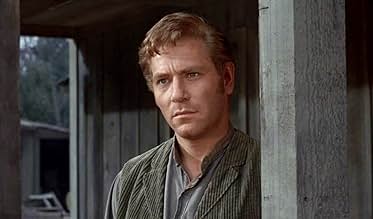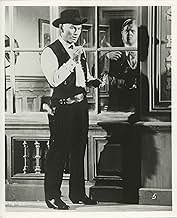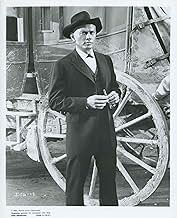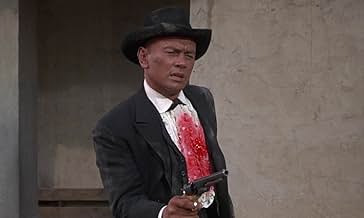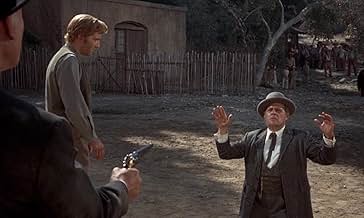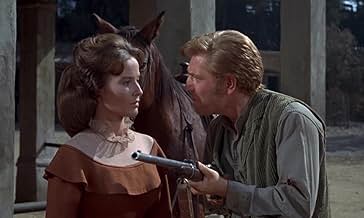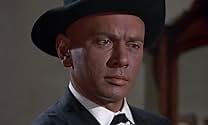Un veterano Confederado regresa a su rancho en Nuevo México y encuentra a su prometida casada con un soldado de la Unión, vecinos hostiles y su tierra vendida por un banquero que lo quiere m... Leer todoUn veterano Confederado regresa a su rancho en Nuevo México y encuentra a su prometida casada con un soldado de la Unión, vecinos hostiles y su tierra vendida por un banquero que lo quiere muerto.Un veterano Confederado regresa a su rancho en Nuevo México y encuentra a su prometida casada con un soldado de la Unión, vecinos hostiles y su tierra vendida por un banquero que lo quiere muerto.
- Dirección
- Guionistas
- Elenco
- Manuel
- (as John Alonzo)
Opiniones destacadas
d'Estaing's drunken rampage through the town came as a shock; the place must have been typical of many of the postbellum period, and its racism, venality and corruption as portrayed in the film didn't seem to justify a hired assassin's rage. It would have been better had d'Estaing been exposed to more overt racism than a patronising suggestion that he finds accommodation in a Mexican establishment.
No great surprises in the ending, but again it wasn't convincing when the Anglo-Americans united with the Mexicans in a gesture of respect.
Take away Brynner and this would have been an extremely average Western.
Nattily dressed in a black suit and a ruffled white shirt, Jules is the strong, silent type, equally adept at playing poker, reciting poetry, and playing the harpsichord as he is engaging in "work and play" with his guns. He is well paid to finish the job but soon discovers that his prospective victim may be more honest than those who are joined against him. Although he makes the statement that he is no longer human, Jules' actions prove otherwise as he develops a sympathy for Weaver, becomes attracted to Ruth, and finds aid and comfort with the Mexicans in the village who have been shunted to the outskirts of town by the corrupt bosses. When Jules, seething with frustration, goes on a drunken rampage and nearly destroys the town single handedly, Sam makes a truce with Matt to get rid of the mysterious stranger and the showdown is set.
Yul Brynner turns in a compelling performance as the son of a slave who wants justice more than another payday. While there is a tendency in many films to glorify murderers for hire, we can relate to Jules more as a flawed human being with a troubled past than as a cold-blooded killer. Unfortunately the other characters are not as well developed and George Segal seems miscast as the vengeful war veteran. Janice Rule is lovely but is given little to do except stand around and look pensive. The less said about the musical score the better. Suffice to say, it did not add to the pleasure of watching this film. Being a Yul Brynner fan, however, I found Invitation to a Gunfighter a satisfying experience, a film whose themes of racism and interracial love were advanced, even for 1964 when consciousness about civil rights was exploding.
The acting is all over the board in this one, as well. Brynner's performance can't be faulted; he's his usual simmering, silent presence, but seems miscast in a role which could have been quite interesting if it weren't so poorly-written. Janice Rule seems confused in her role as Ruth Adams (and well she should be, forced to serve as the love interest between--count them--three men, all trying to kill each other at some point or another), and spends most of it looking vaguely sad and disinterested, and Pat Hingle is neither evil enough nor serious enough to make a compelling villain. Clifford David fares better as the perpetually angry Crane, and George Segal, as the unfortunate Matt Weaver, is just about the only member of the cast that seems to have any idea what he's doing. The rest of the townsfolk are a mixture of clichés and stereotypes that make it seem as though Yul Brynner mistakenly wandered onto the set of "Blazing Saddles." Brynner's presence, and the multi-layered, operatic scale of the plot might warrant repeat viewings, and the film should be credited for trying to tackle weighty issues of morality and racism, but ultimately "Gunfighter" misses its mark. The classic mantra in storytelling is "show, don't tell," and this film doesn't do that, rendering what should have been a very good movie into a very mediocre one.
¿Sabías que…?
- TriviaThe Psicosis (1960) house set on the Universal back lot was the home for the character "Sam Brewster".
- ErroresOne of the Union infantry veterans in the town wears crossed rifles on his kepi. But the cross rifles insignia was not adopted for infantry until after the Civil War. The crossed rifles are what infantry wore during the post Civil War Indian wars. Rather, infantry wore a bugle on their kepis or bummers cap, and as the year is 1865 and as this is a Union infantry veteran from the Civil War, he should be wearing the bugle insignia and not the crossed rifles insignia.
- Citas
Sam Brewster: Is your name Jewel?
Hotel Owner: The hotel register....
Jules Gaspard d'Estaing: My name is
[d'Estaing writes his name on a blackboard]
Sam Brewster: Jewels...Gasperd...Die-es-ting
Jules Gaspard d'Estaing: Jules...soft j, silent s...Gaspard...silent d...d'Estaing...just a touch of dipthong.
- Créditos curiososOpening credits prologue: NEW MEXICO TERRITORY - 1865
- ConexionesReferenced in Una questione d'onore (1966)
Selecciones populares
- How long is Invitation to a Gunfighter?Con tecnología de Alexa
Detalles
- Fecha de lanzamiento
- País de origen
- Idioma
- También se conoce como
- Poziv revolverasu
- Locaciones de filmación
- Productoras
- Ver más créditos de la compañía en IMDbPro
Taquilla
- Presupuesto
- USD 1,800,000 (estimado)


